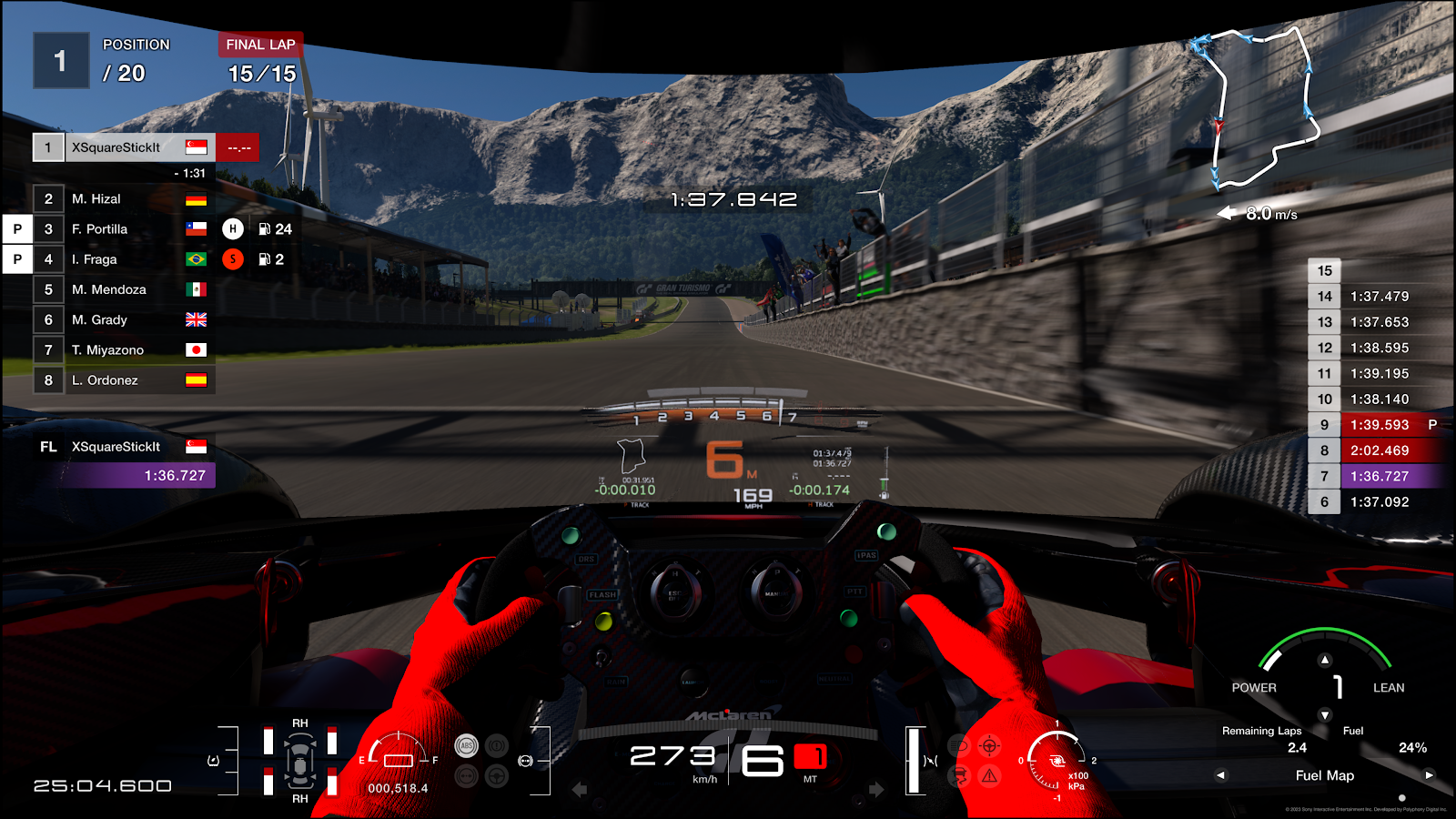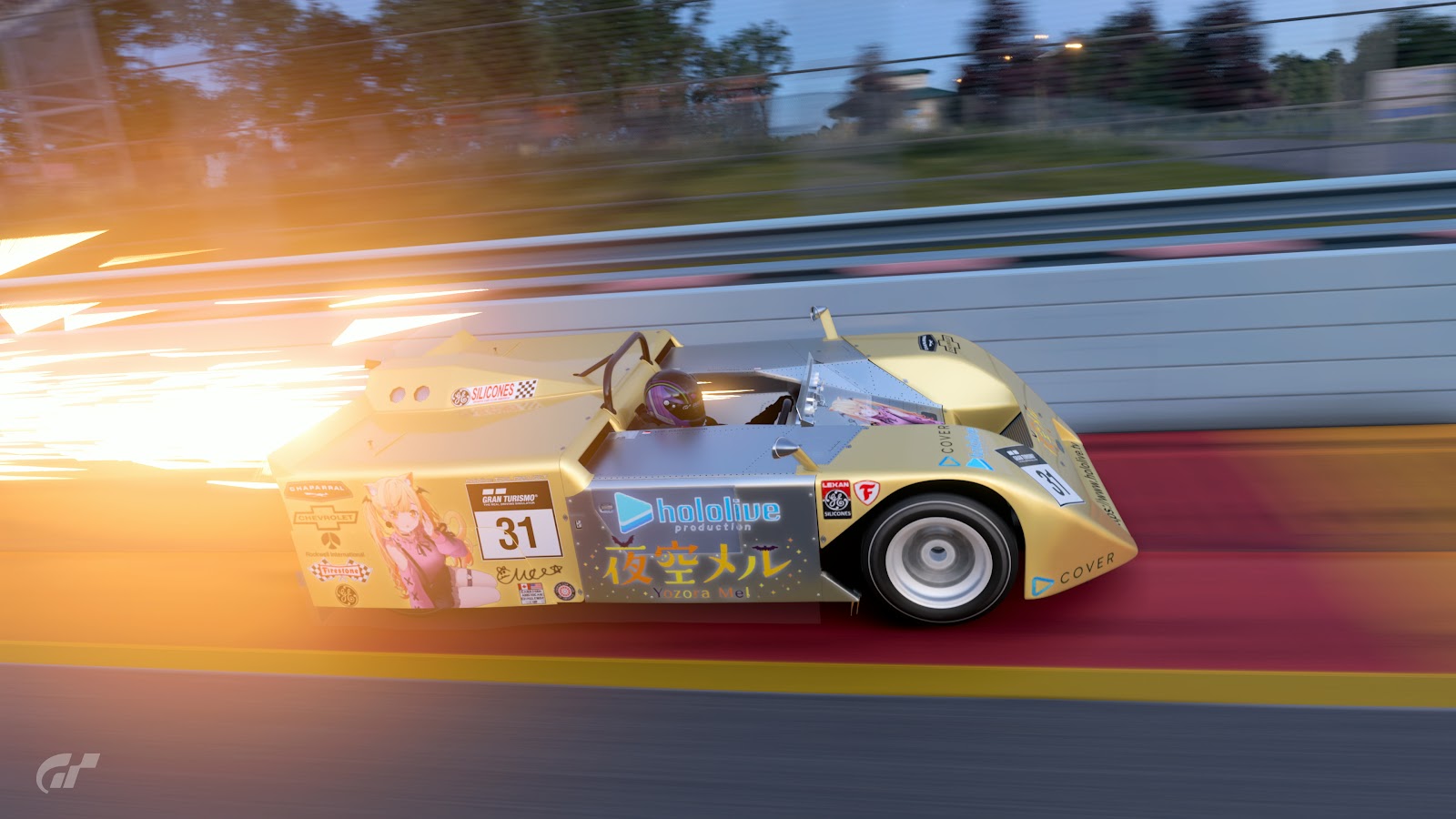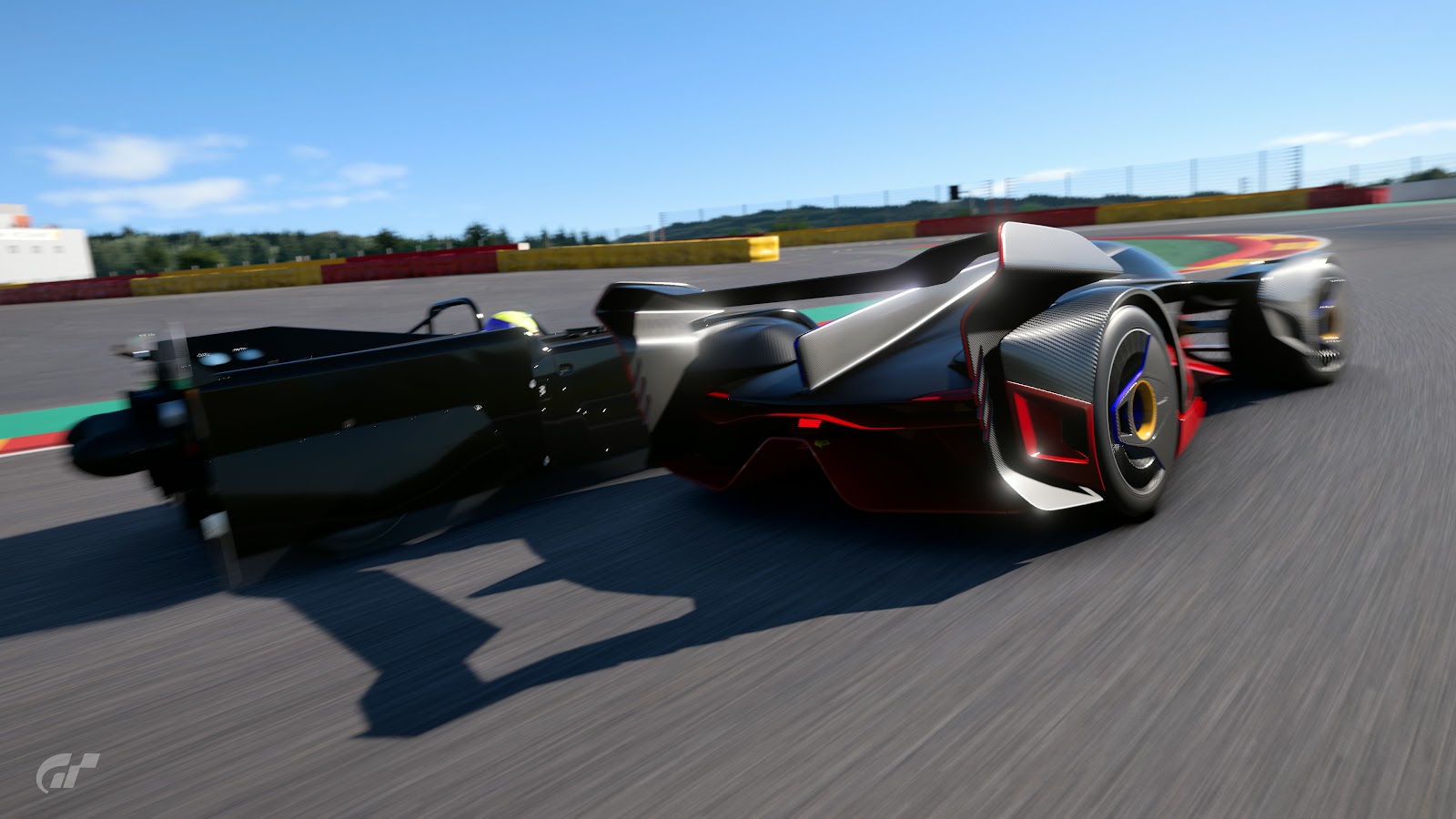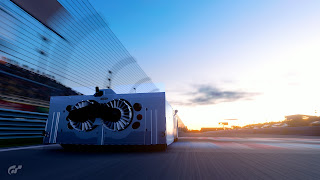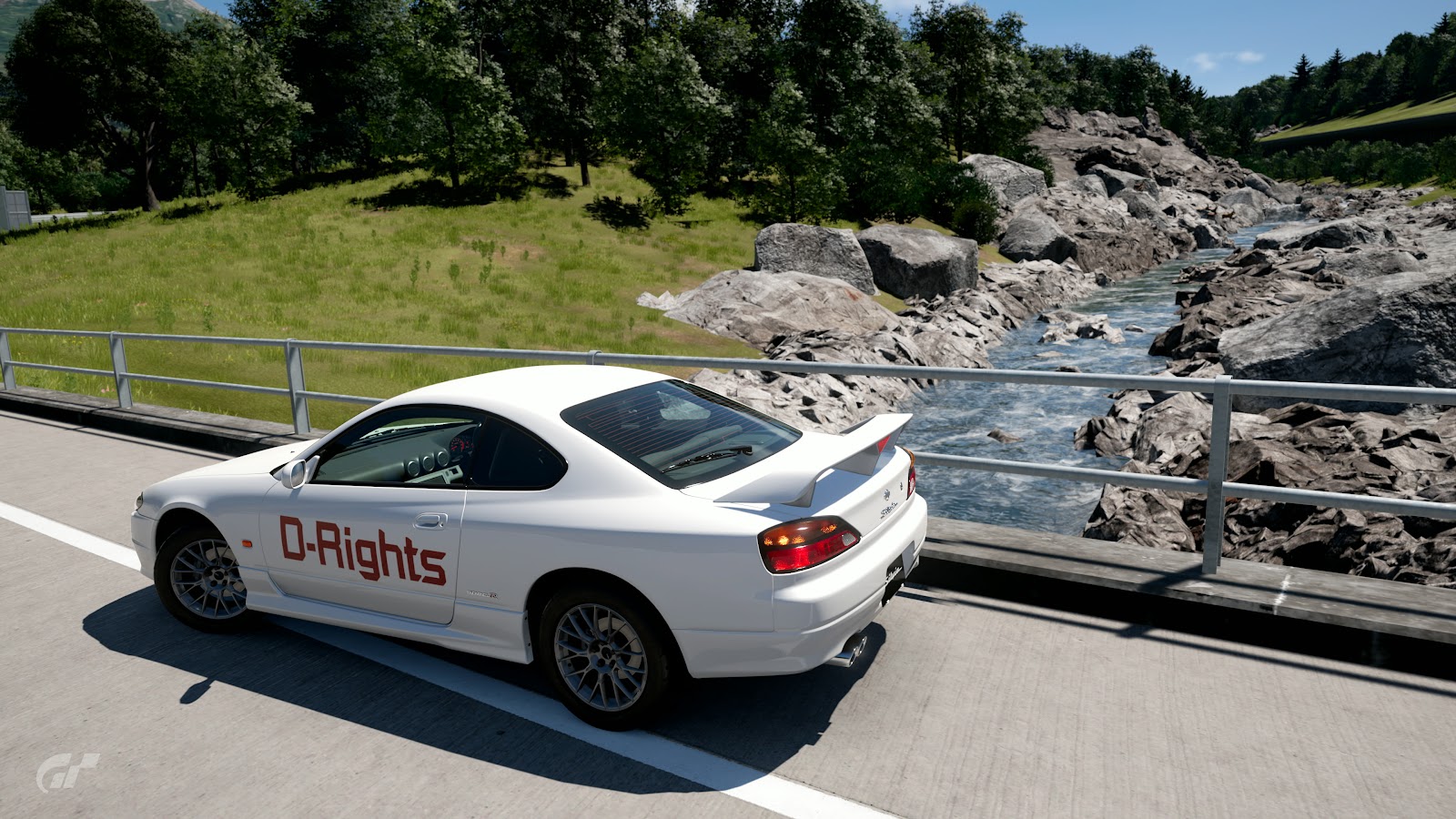"Oh, and I drove the 2J around the (Sardegna) grind race. Fucking hell it's mega. I can 't wait to review it. Might be COTY material." — me to Obelisk, 05/06/2023 10:59 PM.
Well, here we are.
I've always loathed high–downforce cars. Most of it is because I'm terrible at driving them, yes, but I genuinely feel that downforce is the stupidest thing to exist in motorsport; not only does dirty air produce snooze fests of races, but it also necessitates that the cars hug the ground as closely as possible to fully capitalise on ground effects, which in turn necessitates that the suspension be set up to be unforgivingly stiff, making the cars nervous wrecks at low to mid speed, especially around circuits paved with less obsessive perfectionism than a photoshopped supermodel's face. I've never liked how I've just had to blindly trust a car at breakneck speeds just to make a turn, instead of slowly feeling and working my way up to speed. And if the car doesn't turn enough, is it because I'm going too slow, or too fast?
All that nonsense, just so the cars go faster in select turns in clean air? That's not racing; that's just hollow spectacle. I know I'm in the microscopic minority when I say this, but I genuinely think that downforce is a blight onto motorsport. As long as the car isn't taking off on the straight, that's enough downforce for me. But maybe I feel that way because modern motorsports are doing downforce all wrong; something that Jim Hall and Hap Sharp realised as soon as their fifth applied aerodynamics racing prototype back in 1970, when they switched from sticking upside–down airplane wings on their 2H racecar to a sleek, almost featureless box of a car in the 2J.
Unless you're a cat, it's what's in that box that properly excites; a 7.6 Litre Naturally Aspirated V8 engine producing 683HP and capable to revving to an unusually high 8,000rpm, mated to a lightning quick 3 speed stick shift automatic gearbox (don't... ask me about that), good for an as–tested top speed of 356km/h (221mph)... but nobody cares about that. Rather, it's the 247cc, two–cylinder Rockwell JLO snowmobile engine that gets all the attention and earns the nicknaming rights to the "sucker car"—it powers a pair of 17–inch fans that suck air from below the car and jettisons them out the rear, creating an area of low pressure underneath the car to cause the atmospheric air around the car to naturally push the car down into the ground, not to mention generating just a tad bit of forward thrust for good measure. All told, the 2J could reportedly generate a literal tonne of downforce with its fans, or 2,200lbs for our genius American friends. For some context, a modern day, cutting edge track toy, the Elemental RP1, can only generate that same amount at 150mph. The 2J could make that downforce at any speed, even at a standstill, regardless of whether or not it's following any other car (which is not very likely at all).
Oh, and the mass of the 2J? A mere 821kg (1,810lbs). Lighter even than the Kei car we tested for Week 2.
All these jaw dropping facts and figures, and I haven't even told you what the car felt like in practice! In modern Formula cars and even DTM and GT500 machines without ABS, the driver has to gradually ease off the brakes as the car slows down and the downforce washes off the car to prevent wheel lockup when braking at low speeds, resulting in a sharply waning deceleration performance in conjunction with the drag generating wings and splitters. In the 2J, because the downforce is entirely independent of the speed of the car, the entirety of the brake pedal can be used without worry to slow the car to a dead stop the dry, and the tyres won't as much squeak, providing strong, sustained, and constant deceleration all the way to the turn–in of a corner with its large ventilated discs, allowing drivers to brake for corners later than common sense would suggest, even for a car that barely tips the scales. Because of its always–on downforce, the 2J will utterly destroy even modern Racing Medium slicks equipped Group 1 machinery in low speed corners, while itself wearing 50 year old Firestone Racing Hard tyres. In the mid speed sections, it matched, or even slightly bettered, the corner exit speeds of my 2008 Epson NSX GT500, with the 2J finally losing out to the echelons of modern day performance somewhere around the 220km/h (137mph) mark in my estimation, where the downforce level of modern day prototypes finally overtakes the Can–Am Cleaner. In other words, it takes a track with many high speed sweepers and a tyre advantage for a modern LMP or a VGT convert to be able to fight the 2J on somewhat equal pace!
But, while they can match pace with the 2J under very select scenarios, those modern machines can do absolutely nothing to even palely mimic the 2J's tyre longevity; thanks to its extremely lightweight package, and possibly due to its immense downforce minimising tyre scrubbing, the 2J's tyre life is simply u n e t h i c a l ! Running the 2J and a McLaren Ultimate VGT Gr.1 both on Racing Hard tyres with horrific power detunes to fit under the 800PP limit of the lucrative Sardegna WTC800 event, the McVGT from the future was about a quarter way through its rear right tyre at the end of the 15 laps with no tyre change, and was already starting to feel skittish to drive.
The wear was so minimal, it genuinely made me think that the developers forgot to code in tyre degradation for the 2J for a good portion of the race! That's probably a good thing, because I have no idea how long it'd take a pit crew to change the blocked off rear tyres on this fridge. While the 2J sucks fuel like its going out of fashion, its nearly nonexistent tyre wear means that the car just keeps getting faster and faster as the event wears on and the car gets even lighter with less fuel!
And that's not all! Because the 2J always has its one tonne downforce at any speed, it's affected much less by the rain, which sharply slashes the speed, and therefore downforce, of cars which rely on passing air to generate grip. The spray the 2J would kick up and jettison out the rear into the faces of its competitors sadly doesn't seem to be simulated, but the 2J was ultra composed and surefooted even in the wettest of conditions with full wet tyres, especially for something capable of the speeds it does, allowing drivers to carry what would qualify as reckless speeds by any daredevil into corners. In the braking zones, I could use about than 3/4 of the brake pedal without locking the wheels, meaning it can even reign back in all that speed in the twisties! If you thought the 2J was fast in the dry, wait till some rainclouds appear over the track!
Unfortunately, when it came time for us to run the 2J full tilt in our weekly lobbies, I came to absolutely loathe the damn thing. You see, all the praise I had heaped on the car prior were a result of slow driving, either cautiously feeling out the grip levels in the rain, or conserving fuel with a hefty detune. When ran at full tilt, the 2J becomes a moody, psychotic, and unpredictable murderer in a box.
The Chevrolet V8, despite being NA, is heinously peaky, making peak power just a thousand revs below its rev limit of 8,000rpm, but it doesn't even have to do 7,000rpm to break traction on the rear, in spite of its long, 190km/h (118mph) capable first gear. In practice, I notice a horrific spike in power somewhere around the 6,300rpm range when the engine finally "wakes up", making this NA unit kick the rear with almost as much ferocity as a torturously turbocharged tiny engine, with said spike being a prominent problem in 2 of its 3 forward gears. Drivers of the 2J then, will have to become very, very familiar with the very specific note of the engine raising to 6,3, and actively lift off the throttle mid turn even before traction has been broken, because when this car goes, it goes in an instant without any warning whatsoever, worse so than modern cars with conventional aero.
You know how, with experience, you quickly learn to avoid turning too much while going over a rumble strip in the corner exit, or right at the treshold of locking up the front tyres when braking without ABS? You learn that because it's very quickly evident that asking a tyre stressed to its limits to do something more simply snaps the car and sends it spearing off into the barriers. Here's the thing, though: in a conventional racecar, it's the driver who's stressing the tyres, gradually leaning into them when they need that specific tyre to do the most work. It's the driver who presses the brakes, steers the car into a rumble strip, and knowingly brings the car to into danger. In the 2J however, all four tyres are constantly stressed by the always–on downforce. While that means that all four tyres are doing their most work at all times, what that also means is that it takes only the tiniest, almost inconspicuous things to push the 2J over the knife edge it's always teetering over, and the driver doesn't get to feel the car up to its limits, gradually lean into the tyres, or approach the danger themselves; the dangers approach the car instead, and when that happens, the constantly stressed tyres give up with all the immediacy and catastrophe of a blatantly stupid maneuver, such as giving full throttle on steering lock on a rumble strip, even if the offence was something inconspicuous, like a slight tap against a barrier or another car.
One moment, the car has awesome grip, and a slight inconvenience later, the car is upside down, inside out, and on fire in a ditch with some Armco souvenirs. There are no "small incidents" with the 2J, what with it constantly being on the knife edge of grip and the speeds it does; every incident is an ugly, undoubtedly fatal wreck at triple digit mph speeds, because the only way a driver gets to learn what upsets a 2J and what to avoid doing in one is to have at least one big crash with any of the many possible list of offenders: the power spike in the engine. Wandering under braking. Old habits of trying to carry much more speed into a high speed sweeper, thinking more speed equals more downforce. The car naturally understeering. Turning the car too much. A bumpy public road. Kerbs. Contact with another car or a barrier. I cannot even begin to fathom how one would discover its handling limit in the real world in a safe manner, let alone stay near said limits consistently for an entire race. If you have enough virtual lives to live and learn through enough of these wrecks, you'll perhaps be able to come to some sort of understanding with the 2J and make a reasonable attempt to tame it to extract its still bountiful potential. But that of course, requires very painful unlearning and relearning of how to drive. You don't simply hop into a 2J with the experience of having driven other cars and drive it; you 2J a 2J in a very specific 2J–ish way the 2J wants you to 2J it. And I can't help but to wonder if it's worth the pain.
If you've stayed with my long and incoherent ramblings up to this point, then hopefully you'll also pardon me if I become a little dramatic here: driving a 2J is like willfully sustaining emotional trauma. No matter how hard I tried to placate it and take every precaution, it spits me out almost every other corner, and it's distressing. It sows a very big, fast sprouting seed of paranoia into me. When I hopped into my McVGT Gr.1 for a comparison test, the whole session suddenly became fun; I could suddenly drive again. I could compete. I didn't feel like my car wanted to kill me for daring to share a space with it. I ended up 2nd and 3rd in the 2 races I brought my McVGT to race, and I didn't make a single legitimate overtake of any 2J on–track; they all fell off the wayside in ugly accidents one after another. When I braked and turned, the car didn't spit me off. When I lost grip, the car was easy to retrieve. If the McVGT was a person instead of a car, they'd probably be wondering why I'm moved to tears simply by the fact that they didn't elect to stab me in the stomach and spit in my face when we shook hands. It was a trustworthy car, but I had a very difficult time trusting it because of all my previous experiences with a 2J. That race at Laguna Seca was less me racing the 2Js around me and more a race for me to trust a modern racing car again in time before Baron and his bathtub took the chequered flag in the desert.
In other words, learning how to drive a 2J fast almost makes me forget how to drive a normal car properly, and I don't much see the point in that.
And that brings me to a very weird realisation for the conclusion to this long winded post. On paper, the 2J makes all the sense in the world. Fans generating downforce makes all the sense in the world. I would love to see what a modern car in the 2J's spirit would look and drive like, how much of the 2J's problems can be addressed with modern technology, and how much of it is simply inherent to the design. But the fact is, we live in a flawed, illogical world, where the nonsensical is the norm. To survive in it, I've had to spend all my life trying to get accustomed to that nonsense, and roll with it as a matter of course. The 2J then, appears alien and incomprehensible to me, despite it making logical sense. It's like saying formal wear with blazers, suits, ties, and uncomfortable dress shoes make no sense, especially in a hot and humid country like Singapore, but if I showed up to work one day and my boss was in a T shirt, shorts, and sandals, I'd still be thrown for a loop. I can't help but to imagine an alternate reality where the inverse is true; where downforce generating fans are the norm and fixed, speed reliant aero devices were the novelty. Would I hate the McVGT and complain about it as much, while praising a modern Chaparral?
It's impossible to have an apples to apples comparison for the 2J, which makes it impossible to be fair to the 2J when deciding whether its a good car or not. Hell, we've had to reach some 50 years into the future for competent competition to it, and even those had to wear Medium tyres to compete. because it's its own thing, with its own unique strengths and weaknesses that's almost impossible to hold to other cars, and even then, it feels like it's several universes away from anything I could compare against it. Then again, maybe racecars back then weren't meant to be driven and held at their absolute limits or reviewed by sim rig pretenders. I get the feeling that, back then, racecars were more a test of a driver's balls than the cars' technical excellence. The 2J was never set up to face equal competition; it's set up to blow everything out of the water with ease, and thus never had to be driven flat out. Put it up against something else that can fight back, or even against copies of itself, and the Chaparral very quickly becomes roadkill. For every mind blowing strength it has over other cars, it has an equally crippling weakness to cancel it out. It's either qualifying 2 seconds ahead of contemporary cars, or it's broken down in the sidelines. It's either gripping with all the tenacity of a pack of hyenas, or it's lying by the roadside as roadkill. It's either the most frugal car on the track with tyres, or it's drinking like it's just been dumped. It's either the most technologically advanced racing car in the game, or it's a shitbox saddled with a 3 speed auto and overcooked pasta springs. This is a car that could easily clinch both the Beater of the Year and Car of the Year awards simultaneously, and I wouldn't be surprised if it did.
Whatever awards and races it wins or doesn't win, though, the 2J is unequivocal proof to me that downforce is a blight on motorsports, even when done right.





